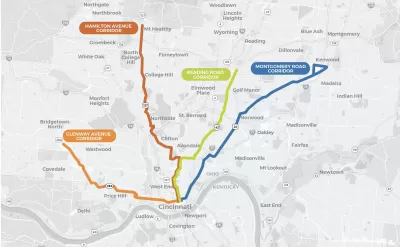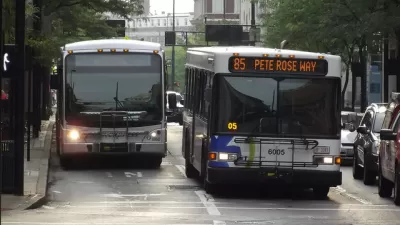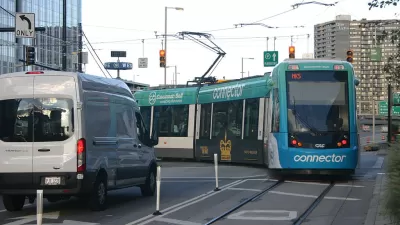A nine-month bus rapid transit planning process, one of the key components of the Cincinnati region’s “Reinventing Metro” long-range transit plan, launched recently.

Cincinnati has launched a planning process for bus rapid transit (BRT) additions to its public transit system as part of the Reinventing Metro plan approved by Hamilton County voters in 2020.
According to the Reinventing Metro website, the BRT planning is underway as a collaboration between Cincinnati’s Metro and the Southwest Ohio Regional Transit Authority (SORTA). A nine-month study will narrow down the choices along four corridors identified by Reinventing Metro as the most popular transit corridors in the Metro system: Glenway Avenue, Hamilton Avenue, Reading Road, and Montgomery Road.
Chris Wetterich reports on the bus rapid transit plans in a paywalled article for the Cincinnati Business Courier. In 2021, the Cincinnati Business Courier identified bus rapid transit [paywall] as one of the most critical infrastructure projects for the region.
Public transit has faced challenges in Cincinnati in recent years, so successful planning of BRT routes would go a long way to instilling public faith in transit in the region. Despite voters approving the sales tax necessary to support Reinventing Metro, the Cincinnati Bell Connector streetcar has been dogged by political opposition, management crises, and low ridership from its inception.
FULL STORY: Cincinnati Metro to vet where to build bus rapid transit lines

Alabama: Trump Terminates Settlements for Black Communities Harmed By Raw Sewage
Trump deemed the landmark civil rights agreement “illegal DEI and environmental justice policy.”

Planetizen Federal Action Tracker
A weekly monitor of how Trump’s orders and actions are impacting planners and planning in America.

The 120 Year Old Tiny Home Villages That Sheltered San Francisco’s Earthquake Refugees
More than a century ago, San Francisco mobilized to house thousands of residents displaced by the 1906 earthquake. Could their strategy offer a model for the present?

Ken Jennings Launches Transit Web Series
The Jeopardy champ wants you to ride public transit.

BLM To Rescind Public Lands Rule
The change will downgrade conservation, once again putting federal land at risk for mining and other extractive uses.

Indy Neighborhood Group Builds Temporary Multi-Use Path
Community members, aided in part by funding from the city, repurposed a vehicle lane to create a protected bike and pedestrian path for the summer season.
Urban Design for Planners 1: Software Tools
This six-course series explores essential urban design concepts using open source software and equips planners with the tools they need to participate fully in the urban design process.
Planning for Universal Design
Learn the tools for implementing Universal Design in planning regulations.
Clanton & Associates, Inc.
Jessamine County Fiscal Court
Institute for Housing and Urban Development Studies (IHS)
City of Grandview
Harvard GSD Executive Education
Toledo-Lucas County Plan Commissions
Salt Lake City
NYU Wagner Graduate School of Public Service





























